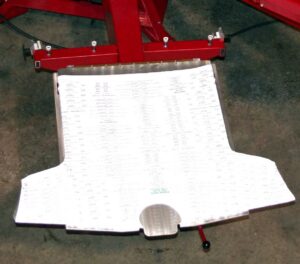

Revolucionando la industria de la serigrafía a través de tecnología de punta y servicio de calidad
Anatol Equipment Manufacturing Co.
1429 S Shields Dr
Waukegan, IL 60085


Revolucionando la industria de la serigrafía a través de tecnología de punta y servicio de calidad
Anatol Equipment Manufacturing Co.
1429 S Shields Dr
Waukegan, IL 60085

What do we mean by «oversized» and «all-over» screen printing? While definitions vary from shop to shop, for this article an oversized print refers to basically a traditional screen print, only bigger than the limits of your standard print job. It’ll take up most of the front or back of a shirt, but it won’t cover the seams, sleeves or collar. An all-over print is a little more complicated. It’s just what its name suggests – the design covers every part of the shirt for a continuous effect.
While oversized printing is relatively straightforward with the right equipment, all-over printing can be a real challenge. Only a small number of screen printing shops are capable of pulling off an all-over print, but the results can be really impressive. Think you’re ready to expand your printing horizons? Be prepared, there are a few challenges you’ll have to confront first.
All-over screen printing can certainly produce unique, eye-catching results that can give your business an edge. Being a successful all-over printer puts you in fairly exclusive company – not many screen printing shops offer this service. But there’s a reason for that. All-over screen printing requires specialty equipment like screens and pallets, maybe even a whole new screen printing machine. All-over printing is trendy and gives your garments a more fashion-conscious look, but are you willing to invest in specialty equipment to accommodate a printing process that could be a temporary fad?
If you plan on tackling oversized or all-over screen printing, you’ll need the right tools. That means screens and pallets designed for large print areas and a press that can hold them. Do you have an exposure unit big enough to handle oversized screens? Or the room to wash, dry and store them? You may need a whole new screen printing press that can accept larger screens and pallets. Anatol’s jumbo presses are built for large-format screen printing – up to 40″ x 30″.

All-over printing will also require more supplies than regular printing; not only ink and emulsion but also spray tack or starch adhesive. While a traditional screen printing pallet fits inside the shirt, for all-over printing the garment will actually lay on top of the pallet. You’ll need to apply spray tack or starch adhesive to the pallet and the inside of the shirt in order to keep it securely in place and avoid registration issues and misprints. Shirts with all-over printing should be washed before wearing to remove any leftover adhesive.
Not only will you need more ink for bigger print jobs, you’ll also need the right kind of ink. Thick plastisol ink may not print very easily through fine mesh over a large area. Plastisol prints also have a heavy hand, and a shirt printed all-over with thick ink won’t be very comfortable. You’ll want to avoid plastisol if possible and use water-based or discharge inks for a softer result. If water-based ink isn’t an option, you can add reducer to plastisol for a more comfortable final product. Let your customers know if the ink you use for all-over printing will create a print with less vibrant colors than usual. And make sure you’re using shirts that are appropriate to your ink!

Another challenge of oversized screen printing is screen preparation. When creating your positives, you’ll either need a large-format printer, or you’ll have to print the positive in smaller pieces and tape them together. This can create issues if you’re not careful. For example, the stencil may end up with varying opacity if the pieces overlap. Aim for the highest possible opacity when creating your positives.
Having the right equipment is one thing, but the real key to a successful oversized or all-over screen print is the artwork. Large-format screen printing is your opportunity to show off your art skills (or for your customers to show off theirs). That being said, you can’t break all the rules. Make sure any important design elements won’t be cut off when printing. Use a template when setting up your artwork to ensure proper placement for elements like logos and text. Keep in mind that your design may be used to print on multiple shirt sizes – make sure your artwork works well on whatever sizes you’ll be printing. Your logo may look great on an XL, but will it get cut off on a small? You may also need separate artwork if you plan on printing women’s sizes. Because of the greater time and expense involved, make sure to send a proof to your customers for approval before printing.
All-over screen printing is a time, effort and resource-consuming process. Be sure to explain to your customers that they can expect a longer turnaround time than with regular printing. Also make sure you’re up front about any additional fees you’ll be charging to cover the additional setup, supplies and labor. Decide what minimum order makes sense for your business and clearly state your policy to your customers. As always, being as transparent as possible is the best way to keep your customers happy.
Interested in going big? Anatol manufactures pallets for all size applications and screen printing equipment to handle a wide variety of print areas. We’d love to get you the tools you need to succeed with large-format screen printing. Let’s talk about opening up new printing possibilities!
Your message was successfully sent!